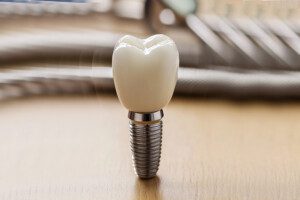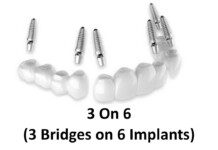
Definition of Dental Implants
Dental implants are artificial tooth replacements designed to substitute for missing teeth. They serve as a sturdy foundation for either permanent or removable replacement teeth, tailored to match your natural teeth. Unlike dentures or partials that rest on the gum line, dental implants are surgically anchored into the jawbone, providing a secure base for the replacement teeth. This innovative dental solution mimics the entire structure of a natural tooth, including the root, ensuring a stable and long-lasting fit. Dental implants play a pivotal role in dental restorations, helping to maintain oral health, jawbone integrity, and facial structure, while also offering the look, feel, and function of natural teeth.
Materials Used in Dental Implants
One can only stop and marvel at man’s ingenuity over the years in this arena of research. The materials in which dental implants came into development from their very beginning hundreds of years ago, range from gold ligature wire to shells, from ivory to chromium, from cobalt to iridium and platinum. From spiral stainless steel implant designs to double helical creations and endosseous root forms, dental researchers and clinicians have generated many different structures over the years to replace the positions that natural teeth once held. Here, we delve into the primary materials used in dental implants today in the 2020s: Titanium, and Zirconium (ceramic). (And the materials for implant prostheses, ranging from Polymers and Composites to Porcelain and Zirconium)
- Titanium: The first titanium dental implant was placed in a human volunteer in 1965 by orthopedic surgeon Dr. Per-Ingvar Brånemark. After six months, the implant integrated with the bone tissue and lasted for 40 years. Today, titanium is the most used material for dental implants due to its exceptional strength and durability. Its properties are particularly well-suited for long-term oral use. Titanium implants are known for their high success rate, largely due to the material’s ability to fuse well with bone, a process known as osseointegration. This strong bond ensures the stability of the implant, making it an ideal choice for a tooth root replacement.
It is important to point out here that most dental implants are not PURE titanium, but from a special Medical Grade Titanium, which also has aluminum and vanadium in them. For more details on this, refer to this article from NIH or this article about understanding titanium grades.
The biocompatibility of titanium is another significant advantage. It is non-toxic and is not rejected by the body, making it an excellent option for most patients. Additionally, titanium’s resistance to corrosion contributes to the implant’s longevity, ensuring that it remains intact and functional for many years.
- Zirconia/Ceramic: Ceramic dental implants are also known as Zirconia implants because they are made from a tooth-colored ceramic material called zirconium oxide. Zirconia-based implants are increasingly popular as an alternative to titanium (because they are white, not grey). This offers a more natural appearance, which is an advantage for some patients. (Especially for implants that are placed in areas where the supporting bone and gum tissues are very thin).
Zirconia implants are also biocompatible and demonstrate a strong bond with the jawbone. However, it is well documented that titanium implants still hold a significant edge in terms of long-term research and documented success rates. And because Zirconia is not as strong as Titanium, they are not as strong and durable.
The following paragraph was copied directly from the website of the largest ceramic dental implant manufacturer regarding the challenges with ceramic implants: “Fewer clinical indications: At present, the clinical indications are limited compared to titanium implants. The current use of ceramic implants as a solution for tooth loss is mainly for single tooth replacement and bridge cases. There may be additional limitations in surgical and loading protocols.”
Materials Used in Dental Implant Prostheses
- Zirconia/Ceramic: Ceramics are often used for the visible parts of dental implants due to their aesthetic properties and strength. Zirconia crowns and bridges are stronger than porcelain-fused-to-metal prostheses because of the way they are milled. Instead of the ceramic being fused to the metal (and more easily chipped), the zirconia is milled into a single unit, whether it’s a single tooth, a short bridge or an entire arch. They can be color-matched to the surrounding teeth, providing a natural appearance. The material is also known for its resistance to staining and wear, making it an excellent choice for dental applications where appearance is a key concern.
- Porcelain: Porcelain (fused-to-metal) is frequently used for the crown portion of the implant due to its ability to mimic the look and feel of natural teeth. It reflects light in a similar way to natural tooth enamel, which is why porcelain crowns can achieve such a lifelike appearance.
However, porcelain can be more brittle than other materials, posing a risk of chipping or cracking. Despite this, the material’s aesthetic benefits often make it the preferred choice for the visible parts of dental implants (crowns or bridges) depending on the restoration and bite forces placed on it. It might be a good choice for a single crown, or a short bridge on a patient who doesn’t grind or clench their teeth.
- Polymers and Composites: In some cases, polymers and composites may be used in dental implant restorations. The most common is Polymethylmethacrylate (PMMA). These materials can be very beneficial in specific situations due to their lighter weight and lower cost. They are most often used in implant dentures. They can also be easier to manipulate and shape, which is advantageous in certain implant procedures.
The main disadvantage of polymers and composites is their lack of strength and durability compared to metals and ceramics. They may not be suitable for all patients or situations.
Biocompatibility
Titanium is the most used material for dental implants due to its exceptional biocompatibility. It has the unique ability to fuse directly to bone, a process known as osseointegration, making it an ideal choice for implants. This fusion ensures that the implant remains securely anchored in the jawbone, providing a stable foundation for the replacement tooth. Zirconia implants are also biocompatible but are relatively new on the scene and their success (85%-93%) rate isn’t nearly as high as titanium (93%-97%).
Many patients might think that because they have other metal allergies, they will be allergic to titanium implants. The truth is that it’s much rarer than you think. Allergies to titanium are exceedingly rare. Titanium is a biocompatible material, meaning it is generally well-tolerated by the human body. It is used not only in dental implants but also in joint replacements, bone plates, and other medical devices.
In recent studies, it has been reported that only 0.6% of the entire population have an allergic reaction to titanium. We have not yet seen a single patient with this in over 30 yrs. of placing dental implants, and there are only a small number of cases reported in the medical literature. When they do occur, symptoms can include localized inflammation, pain, swelling, redness or discomfort at the implant site. However, these symptoms can also be caused by other factors, such as infection or improper implant placement.
Zirconia, a ceramic material, has recently emerged as a popular choice due to its tooth-like color. While zirconia implants are still relatively new compared to titanium, they are gaining popularity for their aesthetic and biocompatible properties. We do not yet place these implants in our practice, as we don’t feel they’ve tried and tested to the same degree as titanium implants, and the success rate isn’t as high. We are open to it in the future, once there’s more of a track record, so stay tuned!
Maintenance and Durability
Dental implants are designed to endure the wear and tear of everyday oral functions. However, their longevity can be affected by factors like the patient’s oral hygiene, lifestyle choices (such as smoking). Habits (like clenching, grinding), and the presence of any underlying oral health issues (like uncontrolled diabetes and other conditions). Regular dental check-ups are crucial to monitor the condition of the implants and address any issues early.
Maintenance practices for dental implants are basically the same as with natural teeth, as far as brushing and flossing go. Brush twice daily and floss regularly. Just because they can’t decay like natural teeth, doesn’t mean you can skip the brushing and flossing. The health of your gums and supporting bone is vital to implant success. However, due to their ceramic nature, zirconium implants do require a bit more care to avoid chipping. Avoid grinding or clenching- as they may not stand up to the forces.
Using a non-abrasive toothpaste and a soft-bristled toothbrush is recommended. Regular dental visits are important for both types of implants to ensure their longevity and to address any potential issues like loosening or wear.
Conclusion
In summary, dental implants stand as a testament to the remarkable strides made in dental technology. The use of diverse materials has enabled the creation of implants that not only closely mimic the natural appearance of teeth but also offer unparalleled durability and strength. The biocompatibility of these materials plays a pivotal role in their success. Their biocompatibility ensures that they integrate seamlessly with the body without causing adverse reactions. Maintenance and durability are crucial aspects of dental implants, with regular oral hygiene and dental check-ups being an integral factor. As dental technology continues to evolve, the future of dental implants looks more and more promising. They offer an improved quality of life to individuals seeking reliable and aesthetically pleasing tooth replacement solutions.






